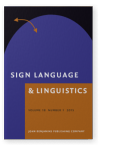Researching linguistic features of text genres in a DGS corpus
The case of finger loci
In this article, we investigate the referential and textual functions of finger loci, that is, the pointing towards one or more fingers of the weak hand in signed discourse. The first part of the article deals with the theoretical discussion about referentiality and the related notions of definiteness and specificity in the literature on spoken languages. The second empirical part of the article shows that the use of finger loci in German Sign Language (DGS) varies according to the genre of signed discourse, fulfilling not only referential but also textual functions. Furthermore, formal variations within the use of finger loci reflect referential gradation and specificity.
References
Biber, Douglas
1995 Dimensions of register variation: a cross-linguistic comparison. Cambridge: Cambridge University Press.


Dryer, Matthew
2011 Indefinite articles. In
Matthew S. Dryer &
Martin Haspelmath (eds.),
The world atlas of language structures online. Munich: Max Planck Digital Library, chapter 38. Available online at
[URL] (last accessed on 25-09-2013).

Ebbinghaus, Horst & Jens Heßmann
1996 Signs and words: Accounting for spoken language elements in German Sign Language. In
Ronnie Wilbur &
William Edmondson (eds.),
International Review of Sign Linguistics. Vol. 11, 23–56. Hillsdale, NJ: Lawrence Erlbaum.

Engberg-Pedersen, Elisabeth
1993 Space in Danish Sign Language. The semantics and morphosyntax of the use of space in a visual language. Hamburg: Signum Verlag.

Givón, Talmy
1982 Logic vs. pragmatics, with human language as the referee: Towards an empirically viable epistemology.
Journal of Pragmatics 61. 35–53.


Greenberg, Joseph H
1978 How does a language acquire gender markers? In
Joseph H. Greenberg,
Charles A. Ferguson &
Edith Moravcsik (eds.), Universals of human language, 47–82. Stanford: Stanford University Press.

Hansen, Martje
2008a Raum- und Körpernutzung in Texten der Deutschen Gebärdensprache (DGS): Teil I: Textkohäsion und Referenzstrukturen.
Das Zeichen 22(79). 274–284.

Hansen, Martje
2008b Raum- und Körpernutzung in Texten der Deutschen Gebärdensprache (DGS): Teil II: Thematische Entfaltung und graduelle Referenzialität.
Das Zeichen 22(80). 442–456.

Hansen, Martje & Jens Heßmann
2013 Register und Textsorten in der Deutschen Gebärdensprache: Eine korpusbasierte Annäherung.
Zeitschrift für Angewandte Linguistik 571. 133–156.

Hawkins, John
1978 Definiteness and indefiniteness: A study in reference and grammaticality prediction. London: Croom Helm.

Hawkins, John
1991 On (in)definite articles: Implicatures and (un)grammaticality prediction.
Journal of Linguistics 27(2). 405–422.


Heßmann, Jens
2001 Gehörlos so!: Materialien zur Gebärdensprache. Hamburg: Signum Verlag.

Heusinger, Klaus von & Udo Klein
2013 The distribution of two indefinite articles: The case of Uzbek. In
Cornelia Ebert &
Stefan Hinterwimmer (eds.),
Different kinds of specificity across languages, 155–176. Dordrecht: Springer.


Himmelmann, Nikolaus
1997 Deiktikon, Artikel, Nominalphrase: zur Emergenz syntaktischer Struktur. Tübingen: Max Niemeyer Verlag.


Himmelmann, Nikolaus
2001 Articles. In
Martin Haspelmath,
Ekkehard König,
Wulf Oesterreicher &
Wolfgang Raible (eds.),
Sprachtypologie und sprachliche Universalien. Ein internationales Handbuch, 836–841. Berlin: de Gruyter.

Hopper, Paul & Sandra Thompson
1993 Language universals, discourse pragmatics, and semantics.
Language Sciences 15(4). 357–376.


Jackendoff, Ray
1983 Semantics and cognition. Cambridge, MA: The MIT Press.

Johnston, Trevor & Adam Schembri
2007 Australian Sign Language. An introduction to sign language linguistics. Cambridge: Cambridge University Press.


Koch, Peter & Wulf Oesterreicher
1990 Gesprochene Sprache in der Romania. Tübingen: Max Niemeyer Verlag.


Liddell, Scott K
2003 Grammar, gesture, and meaning in ASL. Cambridge: Cambridge University Press.


Liddell, Scott, Marit Vogt-Svendsen & Brita Bergman
Lyons, Christopher
1999 Definiteness. Cambridge: Cambridge University Press.


Lyons, John
1977 Semantics. Cambridge: Cambridge University Press.

Miller, Christopher
1994 Simultaneous constructions in Quebec Sign Language. In
Mary Brennan &
Graham H. Turner (eds.),
Word-order issues in sign language, 89–112. Durham: ISLA.

Vater, Heinz
2005 Referenzlinguistik. München: Wilhelm Fink Verlag.

Vermeerbergen, Myriam & Eline Demey
Information text/Glob I: Vibelle TV “Globalisierung I”
URL:
[URL] (last accessed: February 16, 2015).
Information text/Glob II: Vibelle TV “Globalisierung II”
URL:
[URL] (last accessed: February 16, 2015).
Information text/Glob III: Vibelle TV “Globalisierung III”
URL:
[URL] (last accessed: February 16, 2015).
BMAS/Ministry of Labour and Social Affairs
Jobs ohne Barrieren [Jobs without barriers Initiative]”, Part 4.
URL:
[URL] (last accessed: September 7, 2014; in
February 2015 not available anymore).
BMAS/Ministry of Labour and Social Affairs
Teilzeit – Grundsatz der Gleichbehandlung [Part-time – Principle of non-discrimination]”, Part 17.
URL
[URL] (last accessed: February 16, 2015).
Cited by
Cited by 3 other publications
Cohen-Koka, Shirit, Bracha Nir & Irit Meir
Wilcox, Sherman, André Nogueira Xavier & Satu Siltaloppi
2024.
List constructions in two signed languages.
Language and Cognition 16:1
► pp. 57 ff.

This list is based on CrossRef data as of 16 june 2024. Please note that it may not be complete. Sources presented here have been supplied by the respective publishers.
Any errors therein should be reported to them.
